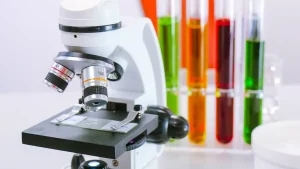The PECVD graphite boat plays a pivotal role in silicon wafer production. It acts as a PECVD carrier, ensuring the efficient deposition of thin films. This tool is indispensable in the semiconductor industry due to its high thermal conductivity and resistance to chemical corrosion. Graphite boats enhance the film deposition process, contributing to the production of high-quality wafers. Their superior properties, such as durability and excellent thermal conductivity, make them essential for processes like Plasma-Enhanced Chemical Vapor Deposition (PECVD). These attributes ensure that the semiconductor industry continues to thrive with advanced manufacturing techniques.

Key Takeaways
- PECVD graphite boats are essential for efficient thin film deposition in semiconductor manufacturing, ensuring high-quality wafer production.
- High-purity graphite composition minimizes impurities, enhancing the integrity of deposited films and reducing contamination risks.
- The durability and thermal stability of graphite boats allow them to withstand high temperatures and reactive environments, leading to consistent performance over time.
- Customization of graphite boats for specific applications optimizes their design, improving efficiency in processes like solar cell manufacturing.
- Using PECVD graphite boats can significantly reduce cycle times and operational costs, boosting production rates and maintaining product quality.
- The environmental benefits of graphite boats include reduced waste and emissions, supporting sustainable manufacturing practices in the semiconductor and solar industries.
- Future advancements in materials and technology will continue to enhance the performance and reliability of PECVD graphite boats, meeting the evolving demands of the industry.
Structure and Functionality of PECVD Graphite Boats
Material Properties
High-purity graphite composition
What makes the PECVD graphite boat an indispensable tool in semiconductor manufacturing? The answer lies in its high-purity graphite composition. This material ensures minimal impurities, which is crucial for maintaining the integrity of the thin films deposited during the PECVD process. High-purity graphite provides a stable and reliable platform for silicon wafers, reducing the risk of contamination and enhancing the overall quality of the final product.
Thermal and chemical stability
Why is thermal and chemical stability important in PECVD processes? Graphite boats exhibit exceptional thermal conductivity and resistance to chemical corrosion. These properties allow them to withstand the high temperatures and reactive environments typical of PECVD applications. As a result, they maintain their structural integrity and performance over extended periods, ensuring consistent and reliable outcomes in wafer production.
Design and Construction
Structural integrity and durability
How do design and construction contribute to the effectiveness of graphite boats? The structural integrity of these boats is paramount. They are engineered to endure the mechanical stresses encountered during the PECVD process. Their robust construction ensures durability, allowing them to support multiple cycles of wafer processing without degradation. This longevity translates to cost savings and increased efficiency in semiconductor manufacturing.
Customization for specific applications
Can graphite boats be tailored for specific needs? Absolutely. Manufacturers can customize graphite boats to meet the unique requirements of different PECVD applications. This flexibility allows for the optimization of boat design to enhance performance in specific processes, such as solar cell manufacturing or semiconductor production. Customization ensures that each graphite boat delivers maximum efficiency and effectiveness, tailored to the demands of its intended use.
Contribution to the PECVD Process
Role in Uniform Coating
Ensuring even deposition of materials
How does the PECVD graphite boat contribute to uniform coating? The answer lies in its ability to serve as a stable substrate for material deposition. This stability ensures that the thin films applied during the PECVD process adhere evenly across the silicon wafers. By maintaining a consistent surface, the graphite boat minimizes variations in film thickness, which is crucial for achieving high-quality coatings. This uniformity directly impacts the performance and reliability of semiconductor devices.
Impact on wafer quality
Why is wafer quality so dependent on the PECVD graphite boat? The quality of the wafer hinges on the precision of the film deposition process. Graphite boats, with their superior thermal and chemical properties, provide an optimal environment for this process. They ensure that the deposited films are free from defects and impurities, which enhances the overall quality of the wafers. High-quality wafers lead to better-performing semiconductor devices, making the role of graphite boats indispensable in the industry.
Efficiency in Production
Reducing cycle times
How do graphite boats enhance production efficiency? By reducing cycle times. The robust design and material properties of PECVD graphite boats allow them to withstand rapid heating and cooling cycles. This capability enables manufacturers to process more wafers in less time, significantly boosting production rates. Faster cycle times mean that companies can meet increasing demands without compromising on quality.
Enhancing throughput
What role do graphite boats play in enhancing throughput? Their contribution lies in their durability and reliability. Graphite boats can endure multiple processing cycles without degradation, ensuring consistent performance over time. This reliability reduces downtime and maintenance needs, allowing for continuous operation. As a result, manufacturers can achieve higher throughput, maximizing their production capabilities and maintaining a competitive edge in the market.
Impact on Solar Cell Efficiency
Improved Energy Conversion
How does the PECVD graphite boat influence solar cell performance? The answer lies in its role in depositing anti-reflective coatings and other essential layers. These coatings significantly reduce sunlight reflection, allowing more light to be absorbed by the solar cells. This absorption enhances the energy conversion efficiency, making solar cells more effective in harnessing solar energy. By providing a stable platform for the deposition of silicon nitride films, the PECVD graphite boat ensures that each layer is applied uniformly, maximizing the cell’s ability to convert sunlight into electricity.
What contribution does the PECVD graphite boat make to higher efficiency rates? Its contribution is evident in the improved performance metrics of photovoltaic cells. By facilitating the precise application of coatings, the boat helps achieve optimal thickness and uniformity. This precision minimizes energy losses and boosts the overall efficiency of solar cells. As a result, manufacturers can produce solar panels that deliver higher power outputs, meeting the growing demand for renewable energy solutions.
Long-term Reliability
Why is durability under operational conditions crucial for solar cells? Solar cells operate in various environmental conditions, from intense sunlight to fluctuating temperatures. The PECVD graphite boat’s durability ensures that the coatings applied to the cells remain intact and effective over time. Its robust construction withstands the stresses of repeated thermal cycling, maintaining the integrity of the deposited layers. This durability translates to longer-lasting solar panels that consistently perform at high efficiency levels.
How does the PECVD graphite boat ensure consistency in performance? Consistency is achieved through the boat’s ability to provide a reliable substrate for film deposition. By maintaining uniformity in the application of coatings, the boat ensures that each solar cell performs predictably and efficiently. This reliability reduces the likelihood of performance degradation, allowing solar panels to deliver consistent energy outputs throughout their lifespan. Consequently, the PECVD graphite boat plays a vital role in enhancing the long-term reliability of solar energy systems.
Advantages of Using PECVD Graphite Boats
Cost-effectiveness
Longevity and reduced maintenance
Why do PECVD graphite boats offer cost-effectiveness in semiconductor manufacturing? Their longevity plays a crucial role. These boats withstand the rigors of high-temperature processes due to their robust construction and high thermal conductivity. This durability reduces the frequency of replacements, leading to significant cost savings over time. Additionally, their resistance to chemical corrosion minimizes maintenance needs, ensuring that operations run smoothly without frequent interruptions.
Lower operational costs
How do PECVD graphite boats contribute to lower operational costs? Their efficiency in the deposition process enhances throughput, allowing manufacturers to produce more wafers in less time. This increased productivity translates to reduced energy consumption and labor costs. By optimizing the PECVD process, graphite boats help companies maintain competitive pricing while delivering high-quality products.
Environmental Benefits
Reduced waste and emissions
What environmental benefits do PECVD graphite boats provide? They play a pivotal role in reducing waste and emissions. Their precision in material deposition ensures minimal wastage of raw materials, contributing to more sustainable manufacturing practices. Furthermore, their ability to withstand multiple cycles without degradation reduces the need for frequent replacements, thereby minimizing waste generation.
Sustainable manufacturing practices
How do PECVD graphite boats support sustainable manufacturing practices? Their use aligns with eco-friendly production goals. By enhancing the efficiency of the PECVD process, these boats reduce the overall carbon footprint of semiconductor manufacturing. Their long lifespan and reduced maintenance requirements further promote sustainability by decreasing the demand for new resources. As industries strive for greener solutions, PECVD graphite boats stand out as a valuable asset in achieving these objectives.
Case Study: Ningbo VET Energy Technology Co.
Implementation in Manufacturing
Specific applications and results
Ningbo VET Energy Technology Co. stands as a leader in the PECVD graphite boat industry. They utilize high-purity graphite materials to manufacture boats specifically designed for solar panel production. These boats exhibit low impurity content and high strength, ensuring exceptional performance and longevity. The company has successfully implemented these boats in various manufacturing processes, resulting in enhanced film deposition quality and increased efficiency. By leveraging imported graphite materials, Ningbo VET Energy Technology Co. has achieved significant improvements in the production of solar panels, contributing to higher energy conversion rates and more reliable solar cells.
Innovations and advancements
Ningbo VET Energy Technology Co. continuously innovates to meet the evolving demands of the semiconductor and solar industries. They have introduced advancements in the design and construction of PECVD graphite boats, focusing on customization to cater to specific applications. These innovations include optimizing the structural integrity and thermal properties of the boats, allowing them to withstand the rigorous conditions of PECVD processes. By prioritizing quality and precision, Ningbo VET Energy Technology Co. ensures that their graphite boats deliver consistent and reliable performance, setting new standards in the industry.
Customer Feedback
Testimonials and success stories
Customers of Ningbo VET Energy Technology Co. have consistently praised the quality and performance of their PECVD graphite boats. Testimonials highlight the boats’ durability and efficiency, with many clients noting significant improvements in their manufacturing processes. One customer stated, “The PECVD graphite boats from Ningbo VET Energy Technology Co. have transformed our production line. We have seen a marked increase in throughput and a reduction in cycle times.” Such success stories underscore the company’s commitment to delivering high-performance solutions that meet the needs of their clients.
Industry recognition
Ningbo VET Energy Technology Co. has garnered recognition within the industry for their contributions to the advancement of PECVD technology. Their innovative approach and dedication to quality have earned them accolades from industry experts and peers. The company’s focus on sustainable manufacturing practices and environmental benefits further solidifies their reputation as a leader in the field. As a result, Ningbo VET Energy Technology Co. continues to set benchmarks for excellence in the production of PECVD graphite boats, reinforcing their position as a trusted partner in the semiconductor and solar industries.
Challenges and Solutions
Common Issues
Handling and maintenance challenges
What are the common handling and maintenance challenges associated with PECVD graphite boats? These boats, essential in high-temperature applications like PECVD, require careful handling due to their delicate nature. Mishandling can lead to structural damage, affecting their performance. Maintenance poses another challenge. Regular cleaning is necessary to prevent contamination, but improper techniques can degrade the material. Industries must implement stringent protocols to ensure the longevity and efficiency of graphite boats.
Material wear and tear
Why does material wear and tear occur in PECVD graphite boats? The high-temperature environments and chemical exposure in PECVD processes contribute to the gradual degradation of graphite boats. Over time, these conditions can cause surface erosion and structural weakening. This wear and tear impact the boat’s ability to provide a uniform substrate for material deposition, potentially compromising the quality of the final product. Addressing these issues is crucial for maintaining optimal performance in semiconductor manufacturing.
Innovative Solutions
Advances in material science
How do advances in material science address the challenges faced by PECVD graphite boats? Researchers have developed new graphite composites with enhanced properties. These materials offer improved thermal stability and resistance to chemical corrosion, extending the lifespan of graphite boats. By incorporating these advanced materials, manufacturers can reduce the frequency of replacements and maintenance, leading to cost savings and increased efficiency. These innovations ensure that graphite boats continue to meet the demands of modern semiconductor processes.
Design improvements
What role do design improvements play in overcoming the challenges of PECVD graphite boats? Engineers have introduced design enhancements to increase the structural integrity and durability of graphite boats. These improvements include reinforced construction and optimized geometries that withstand the mechanical stresses of PECVD processes. Customization options allow manufacturers to tailor designs for specific applications, ensuring maximum efficiency and performance. By embracing these design advancements, industries can fully harness the potential of graphite boats, paving the way for innovative applications in semiconductor manufacturing.
Future Trends in PECVD Graphite Boats
Technological Advancements
Emerging materials and designs
What innovations are shaping the future of PECVD graphite boats? The industry is witnessing a surge in the development of new materials and designs. Researchers focus on enhancing the thermal conductivity and resistance to thermal shock of graphite boats. These advancements aim to improve the efficiency and reliability of the PECVD process. For instance, the introduction of high-performance graphite composites offers superior durability and stability. These materials minimize the risks of contamination and particulate generation, ensuring cleaner and more efficient film deposition.
Integration with new technologies
How do PECVD graphite boats integrate with emerging technologies? The integration of advanced technologies is transforming the capabilities of graphite boats. Automation and precision engineering play pivotal roles in optimizing the PECVD process. Manufacturers are incorporating smart sensors and control systems to monitor and adjust the deposition parameters in real-time. This integration enhances the precision and consistency of thin film applications, leading to improved product quality. As technology evolves, PECVD graphite boats will continue to adapt, supporting the demands of cutting-edge semiconductor and solar applications.
Market Growth
Increasing demand in renewable energy
Why is there a growing demand for PECVD graphite boats in renewable energy? The shift towards sustainable energy solutions drives the need for efficient solar cell production. PECVD graphite boats play a crucial role in this transition by enabling the precise deposition of anti-reflective coatings and other essential layers. These coatings enhance the energy conversion efficiency of solar cells, making them more effective in harnessing solar power. As the renewable energy sector expands, the demand for high-quality PECVD graphite boats will rise, supporting the production of advanced solar technologies.
Expansion in semiconductor applications
What factors contribute to the expansion of PECVD graphite boats in semiconductor applications? The semiconductor industry relies heavily on PECVD processes for manufacturing high-performance devices. Graphite boats provide the stability and precision required for uniform film deposition, which is critical for device functionality. The increasing complexity of semiconductor devices necessitates advanced deposition techniques, driving the demand for innovative PECVD graphite boats. As the industry continues to evolve, these boats will play an integral role in meeting the challenges of modern semiconductor manufacturing.
The PECVD graphite boat stands as a cornerstone in advanced manufacturing, particularly within the semiconductor and solar industries. Its high thermal conductivity and resistance to chemical corrosion ensure efficient film deposition, enhancing both quality and productivity. As technology progresses, the role of graphite boats will likely expand, supporting innovations in PECVD processes. Their durability and precision make them indispensable for achieving uniform coatings and superior adhesion. The future holds promising developments, with graphite boats continuing to drive advancements in high-temperature applications.
FAQ
What is the role of Graphite Boats in PECVD?
Graphite boats serve as carriers for substrates during the PECVD process. Their role is crucial, especially when dealing with high temperatures and reactive gases commonly used in thin film deposition. Several reasons make graphite boats favored in this context:
- Thermal Stability: They withstand high temperatures without degrading.
- Chemical Resistance: They resist corrosion from reactive gases.
- Uniform Coating: They facilitate even material deposition.
What are the features of PECVD Graphite Boats?
PECVD graphite boats are essential tools in processes like chemical vapor deposition (CVD) and plasma-enhanced chemical vapor deposition (PECVD) within the semiconductor and solar industries. Key features include:
- High Thermal Conductivity: Ensures efficient heat distribution.
- Resistance to Thermal Shock: Handles rapid temperature changes effectively.
- Durability: Offers long-lasting performance in high-temperature environments.
Where is the graphite boat applied in semiconductor production?
In semiconductor production, graphite boats find application in Plasma Enhanced Chemical Vapor Deposition (PECVD). They act as carriers for silicon wafers, ensuring precise and uniform thin film deposition, which is vital for device performance.
What is PECVD Graphite Boat specialized for?
The PECVD Graphite Boat is a specialized container or carrier made of graphite, used in the PECVD process for depositing thin films on various substrates. Companies like Stanford Advanced Materials (SAM) provide these boats with high purity and competitive pricing, ensuring optimal performance in manufacturing.
Why are Graphite Boats essential in PECVD and high-temperature applications?
Graphite boats are indispensable in processes like PECVD and other high-temperature applications due to their:
- Excellent Thermal Conductivity: Facilitates efficient heat management.
- Durability: Withstands repeated use without degradation.
- Resistance to Chemical Corrosion: Maintains integrity in reactive environments.
These attributes make them ideal for semiconductor manufacturing, solar cell production, and thin-film coatings.
How do Graphite Boats contribute to uniform coating in PECVD?
Graphite boats provide a stable substrate for material deposition, ensuring even distribution across the wafer surface. This uniformity is crucial for achieving high-quality coatings, which directly impact the performance and reliability of semiconductor devices.
What industries benefit from the use of PECVD Graphite Boats?
Industries such as semiconductors, solar energy, and thin-film coatings benefit significantly from PECVD graphite boats. Their ability to handle high temperatures and reactive environments makes them suitable for various applications, including the production of high-performance electronics and renewable energy solutions.
How do advances in material science improve PECVD Graphite Boats?
Advances in material science have led to the development of new graphite composites with enhanced properties. These materials offer improved thermal stability and resistance to chemical corrosion, extending the lifespan of graphite boats and reducing maintenance needs.
What future trends are expected for PECVD Graphite Boats?
Future trends for PECVD graphite boats include the integration of emerging materials and designs that enhance thermal conductivity and resistance to thermal shock. Additionally, the incorporation of smart sensors and control systems will optimize the PECVD process, supporting the demands of cutting-edge semiconductor and solar applications.
How do PECVD Graphite Boats support sustainable manufacturing practices?
PECVD graphite boats align with eco-friendly production goals by enhancing the efficiency of the PECVD process. Their long lifespan and reduced maintenance requirements decrease the demand for new resources, promoting sustainability in semiconductor manufacturing.







